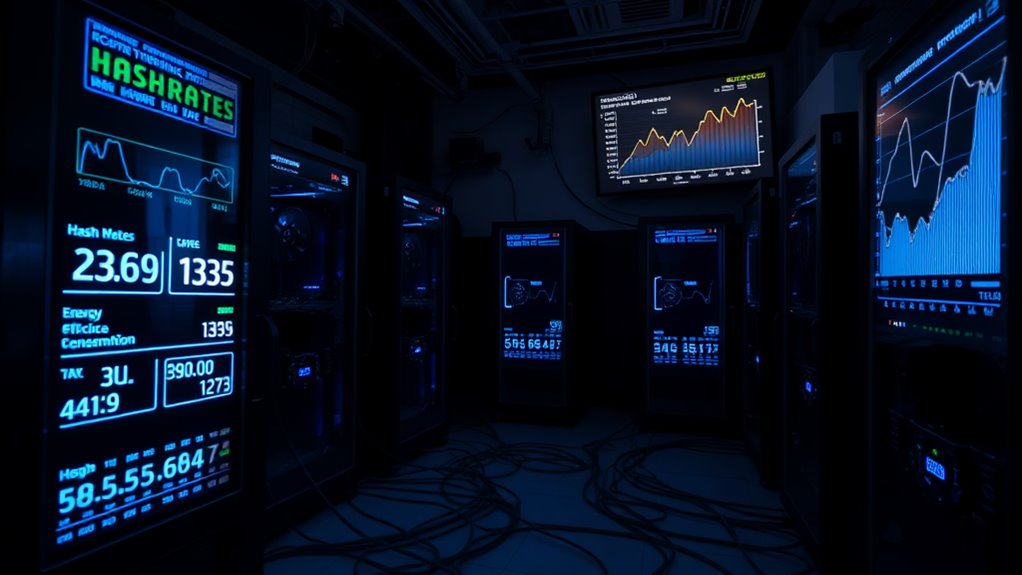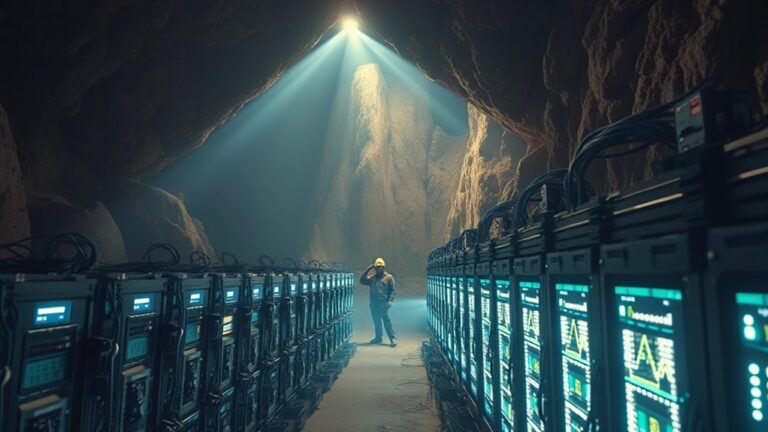
Is Crypto Mining Still Profitable: Trends and Factors for 2025
Crypto mining profitability in 2025 will be influenced by several key factors. The market is projected to grow steadily, with a focus on hardware efficiency and rising energy costs. Advanced technologies, such as ASIC miners and immersion cooling systems, aim to reduce operating expenses. Additionally, regulatory changes and environmental concerns will shape mining operations. Miners may explore cloud mining and alternative cryptocurrencies to diversify their strategies and mitigate risks. More insights can be gained from the upcoming trends and developments in this area.
Key Takeaways
- Profitability in crypto mining is influenced by rising mining difficulty and the upcoming 2024 Bitcoin halving, which reduces block rewards.
- Energy costs are critical; rising electricity prices and regulatory measures may impact overall mining profits significantly.
- Advanced hardware efficiency is essential; ASIC miners offer high hash rates but require regular upgrades for competitiveness.
- Cloud mining presents a cost-effective alternative, allowing newcomers to participate without heavy hardware investments.
- Diversifying cryptocurrency portfolios can mitigate risks and improve profit margins amidst market volatility and regulatory challenges.
Current Market Trends in Cryptocurrency Mining

As the cryptocurrency mining landscape evolves, various market trends greatly shape its future.
The cryptocurrency mining equipment market is projected to grow from $4.89 billion in 2024 to $5.13 billion in 2025, reflecting a compound annual growth rate of 4.8%. This growth is influenced by significant advancements in technology, which lower entry barriers for new miners.
The cryptocurrency mining equipment market is expected to grow to $5.13 billion by 2025, driven by technological advancements.
The total market capitalization of cryptocurrencies has surged to approximately $2.24 trillion, indicating a robust interest in digital assets. Additionally, ongoing regulatory changes worldwide continue to impact the mining environment.
Future projections suggest the market could reach $6.56 billion by 2029, showcasing the potential for continued expansion and innovation within the cryptocurrency mining sector. Furthermore, the increasing focus on renewable energy sources is expected to play a crucial role in enhancing sustainability and reducing costs for miners.
The Impact of Hardware Efficiency on Profitability

The efficiency of hardware plays an essential role in determining profitability in cryptocurrency mining. Various factors influence how well hardware performs, impacting overall returns. Key considerations include:
- Hardware Types: ASICs provide high hash rates but are expensive and algorithm-specific, while GPUs offer versatility and lower costs.
- Performance Metrics: Top ASICs can achieve 298 TH/s with efficiency measures around 18.5 J/TH.
- Cooling Systems: Advanced cooling techniques are crucial for maintaining hardware performance.
- Flexibility: Custom setups, like open-source rigs, can adapt to specific mining needs.
- Technological Advancements: Regular upgrades are necessary to stay competitive in the ever-evolving mining landscape.
In addition, choosing the right GPU performance metrics can significantly enhance the profitability of mining operations. Understanding these elements helps miners make informed decisions about their operations and profitability strategies.
Energy Costs: The Key to Sustainable Mining

Energy costs represent a critical factor in the sustainability of cryptocurrency mining operations. The energy consumption of Bitcoin mining is comparable to that of entire countries, such as Poland, highlighting significant environmental concerns.
Rising electricity prices pose challenges to miners, impacting their profitability. Regulatory measures, including proposed climate taxes on energy usage, aim to address these issues by funding climate action.
Promoting renewable energy adoption through incentives, such as tax credits, could lead to lower operational costs and reduced carbon emissions. However, local restrictions and supply chain limitations complicate this change. Additionally, implementing energy-efficient hardware can enhance profitability while simultaneously decreasing energy consumption and environmental impact.
Exploring Cloud Mining Opportunities

Cloud mining presents cost-effective solutions for individuals interested in cryptocurrency mining without the need for significant hardware investment.
Many platforms are now integrating renewable energy sources, which not only reduces operational costs but also promotes sustainability within the industry.
As cloud mining continues to evolve, these features may attract a wider range of investors looking for efficient and environmentally friendly options. Additionally, the trend of renting cloud computing power from reliable providers is making it easier for newcomers to enter the mining space without extensive technical knowledge.
Cost-Effective Mining Solutions
While many individuals are interested in entering the cryptocurrency mining space, traditional mining methods often present significant barriers, such as high hardware costs and technical complexities.
Cloud mining offers a cost-effective alternative by allowing users to rent hash power from remote data centers. This model provides several advantages:
- Zero Hardware Cost: Eliminates the need for expensive equipment.
- Low Operational Costs: Reduces expenses related to electricity and maintenance.
- Beginner-Friendly: Managed by service providers, making it accessible for non-technical users.
- Flexible Options: Users can choose contract durations to fit their investment strategies.
- Global Accessibility: Makes mining available regardless of local conditions.
These features make cloud mining a viable solution for those looking to participate in cryptocurrency mining without significant upfront investment. Additionally, cloud mining can be particularly beneficial for users who want to avoid the high hardware costs associated with traditional methods.
Renewable Energy Integration
As the demand for cryptocurrency mining continues to grow, integrating renewable energy sources into mining operations presents a promising opportunity for both sustainability and profitability.
Utilizing solar and wind power, mining operations can notably reduce operational costs while minimizing their carbon footprint. This shift not only aligns with global sustainability goals but also appeals to environmentally conscious investors.
Additionally, renewable energy allows for operational flexibility, enabling setups in remote areas rich in these resources.
Cloud mining platforms, like SpeedHash, further enhance accessibility by providing renewable energy-based solutions that eliminate the need for expensive hardware.
This combination of energy efficiency and lower entry barriers makes renewable energy integration a viable path for future mining profitability. Furthermore, adopting sustainable mining techniques not only enhances operational efficiency but also helps mitigate the environmental impact associated with traditional mining practices.
The Role of Alternative Cryptocurrencies

Alternative cryptocurrencies play a significant role in the evolving landscape of crypto mining, offering miners diverse options beyond the dominant Bitcoin.
Alternative cryptocurrencies significantly enhance the crypto mining landscape, providing miners with diverse options beyond Bitcoin.
These alternatives provide various benefits that can enhance profitability for miners:
- Diversified Mining Options: Coins like Ethereum Classic (ETC), Litecoin (LTC), and Zcash (ZEC) are available.
- Algorithm Variety: Different algorithms such as Scrypt and Equihash allow for mining with various hardware.
- Energy Efficiency: Some altcoins focus on reducing energy consumption, which can improve profit margins.
- Community Support: Strong communities can foster adoption and potential price increases.
- Risk vs. Reward: Mining altcoins often presents higher volatility but can yield greater rewards than more stable options.
This diversity allows miners to strategically choose which cryptocurrencies to pursue based on market conditions. Moreover, options like ASIC-resistant algorithms enable miners to utilize more accessible hardware, broadening their participation in the mining ecosystem.
Mining Difficulty and Network Dynamics

Mining difficulty and network dynamics are critical factors that influence the overall landscape of cryptocurrency mining. As blockchain technology evolves, mining difficulty is projected to rise considerably by 2025, making it tougher for miners to secure block rewards.
The increase in hash rate will heighten competition, particularly disadvantaging smaller miners who may struggle to remain profitable. In addition, older mining hardware may become obsolete, urging miners to invest in more efficient technologies. The ongoing fluctuations in mining difficulty will necessitate continuous adaptation to maintain a competitive edge.
The 2024 Bitcoin halving will reduce block rewards, further complicating profitability. Additionally, the centralization of mining pools raises concerns about network security and decentralization.
These dynamics necessitate a careful evaluation of strategies as miners navigate the increasingly competitive environment of cryptocurrency mining.
Regulatory Factors Influencing Mining Operations

What factors shape the regulatory landscape for cryptocurrency mining operations? Various elements influence how mining is governed, affecting profitability and compliance. The evolving regulatory framework includes:
Understanding the multifaceted regulatory landscape is crucial for cryptocurrency miners to ensure profitability and compliance.
- SEC Exemptions: Proof-of-work mining is exempt from federal securities laws, as clarified in 2025.
- State-Level Challenges: Despite federal support, state regulations present hurdles for miners.
- Permitting Processes: Mining operations encounter complexities in obtaining necessary permits, impacting operational continuity.
- Community Feedback: Local residents advocate for responsible mining practices and adherence to regulations.
- International Perspectives: Global regulations vary, with some countries offering incentives while others impose strict restrictions.
Additionally, the International Seabed Authority has established regulatory frameworks that balance economic interests with environmental protection, which can influence mining practices globally.
Understanding these factors is essential for miners aiming to navigate the complex regulatory environment effectively.
Environmental Considerations and Sustainability

The regulatory landscape surrounding cryptocurrency mining is increasingly influenced by environmental considerations, prompting a reevaluation of sustainable practices within the industry.
Bitcoin mining is known for its high energy consumption, estimated at 63 terawatt-hours annually, comparable to Poland’s total usage. This activity generates approximately 86 megatons of carbon emissions, mainly from fossil fuels.
Additionally, PM2.5 emissions greatly impact air quality, affecting millions in the U.S., particularly in areas like New York City and Houston. Water usage and land requirements for mining operations further strain local resources.
However, over 58% of miners now utilize renewable energy sources, and technological advancements are emerging to reduce the environmental footprint, indicating a shift toward more sustainable mining practices is underway. As regulations evolve to focus on consumer protection, the mining sector may face increased scrutiny regarding its environmental impact.
Technological Innovations Shaping the Future

As the cryptocurrency industry evolves, technological innovations are playing an essential role in shaping its future, particularly regarding efficiency and sustainability. Several advancements are influencing the mining landscape:
- ASIC Efficiency: ASIC miners provide higher hash rates with lower energy use compared to GPUs.
- FPGA Mining: Field-programmable gate arrays enhance flexibility and energy efficiency, accommodating various algorithms.
- Cooling Systems: Immersion cooling improves efficiency and protects equipment, extending its lifespan.
- Cost Reduction: The average cost of mining equipment has considerably decreased, making entry easier.
- Energy-Efficient Hardware: Advances in hardware design lead to miners that consume less power while maintaining performance.
These innovations contribute to a more sustainable and profitable future for crypto mining, as efficiency becomes increasingly vital.
Adapting to Market Volatility and Risk Management

Maneuvering the unpredictable landscape of cryptocurrency requires miners to adapt to market volatility while implementing effective risk management strategies. High price fluctuations can lead to significant changes in mining profitability, presenting both opportunities and risks.
To manage these challenges, miners often diversify their portfolios by mining various cryptocurrencies, which helps mitigate losses. Additionally, successful miners employ adaptive strategies, allowing them to respond quickly to market changes.
Regular market analysis and risk assessments enable miners to prepare for volatility, while hedging techniques can offset price risks. Moreover, implementing stop-loss policies serves to limit potential losses during downturns.
Frequently Asked Questions
What Are the Risks of Investing in Crypto Mining for Beginners?
Investing in crypto mining presents risks such as market volatility, regulatory uncertainties, financial leverage, and technological obsolescence. Beginners should carefully assess these factors to navigate potential financial losses and guarantee sustainable investment decisions.
How Do Mining Pools Impact Individual Miner Profitability?
Mining pools enhance individual miner profitability by combining resources, increasing success rates, and providing consistent rewards. Despite reduced autonomy and variable earnings, the collective effort often outweighs the risks, making mining more accessible and efficient.
Can Mining Still Be Profitable With High Transaction Fees?
High transaction fees can enhance mining profitability by providing additional income per block. However, if fees deter user transactions, overall demand may decrease, affecting miners’ earnings. Balancing these factors is essential for sustained profitability.
What Is the Role of Community Support in Mining Projects?
In the whimsical world of mining, community support transforms disparate miners into a united front. Knowledge sharing, collaborative efforts, and sustainable practices emerge, proving that together, they can tackle challenges more effectively than solitary endeavors or wishful thinking.
How Does the Physical Location Affect Mining Operations?
The physical location considerably impacts mining operations by influencing energy costs, regulatory environments, and infrastructure availability. Favorable locations with cheap energy and supportive policies enhance profitability, while environmental regulations can impose restrictions on operations.
Conclusion
In conclusion, the landscape of cryptocurrency mining is evolving, influenced by various factors such as technology, energy costs, and regulatory changes. While certain aspects may appear intimidating, opportunities still exist for those willing to adapt. As miners navigate this shifting terrain, a balanced approach to risk management and sustainability will be essential. By embracing innovation and staying informed, participants in the mining sector can position themselves favorably as they look toward the potential of 2025.












